Solid North

The term "Solid North" refers to the strong electoral support of northern Philippine provinces, particularly those of Ilocandia, to the family of President Ferdinand Marcos specifically, and other politicians of Ilocano descent and economic issues of affecting the Ilocanos in general, such as the tobacco industry. After the ouster of Marcos as a result of the People Power Revolution, electoral support for the Marcoses has waned but there is still significant support for them in the area.
The inclusion of some of the provinces in the Cordillera Administrative Region (CAR) in the Solid North has been questioned. While the lingua franca of the CAR is the Ilokano language, most of its residents are not Ilocanos and are referred to as the " Igorot" by Ilocanos and other lowlanders. These provinces all voted for Marcos while he was in power but have now mostly deviated from the regional voting patterns of the rest of northern Luzon.
Third Republic presidential elections
Before the election of Ferdinand Marcos in 1965,it was President Elpidio Quirino who consistently carried the Ilocano heartland in the presidential elections during which he was a candidate. Despite Ramon Magsaysay's landslide victory in the 1953 presidential election, Quirino still won in his home province of Ilocos Sur, as well as Ilocos Norte, Abra and La Union.
In the 1965 presidential election, Senator Ferdinand Marcos of the Nacionalista Party, from Ilocos Norte, faced the incumbent president Diosdado Macapagal of the Liberal Party, who hailed from Pampanga. Marcos successfully campaigned on the issues of graft, peace and order, and economic progress, although these had been staple campaign issues since independence.[1] Marcos carried not only the Solid North, but most of Luzon as well, with Macapagal only carrying the provinces of Pampanga, Tarlac and Bataan.
While Marcos won an even larger mandate during his successful reelection bid in 1969, support from the Solid North was not as crucial in his victory. Pampanga and Antique in the Visayas were the only provinces that he did not win.
1986 snap presidential election
Marcos eventually declared martial law and stayed in power until 1986, when he called for a "snap election". With his popularity declining after the assassination of Benigno Aquino Jr., Marcos relied heavily on support from the Solid North in the 1986 election, when he faced Aquino's widow, Corazon Aquino. Marcos depended on the Ilocos Region, described as "impregnable to the opposition", and on Eastern Visayas, the home region of his wife, First Lady Imelda Marcos.[2] Marcos was eventually declared the winner but allegations of massive fraud erupted into the People Power Revolution which drove the Marcoses into exile and concluded with Aquino's ascension into the presidency.
Fifth Republic elections
- 1992: Marcos died in 1989, and his widow Imelda ran in 1992 against six other candidates. Fidel V. Ramos, one of the leaders of the People Power Revolution, and the candidate President Aquino campaigned for, won. Another Marcos ally, Danding Cojuangco, won in several provinces of the Solid North.
- 1998: Imelda Marcos was supposed to run anew in 1998, but withdrew a month prior to the election. She had been lagging in opinion polling with only 3% of the support.
- 2004: Fernando Poe, Jr. personally sought the endorsement of Imelda for the presidency when he visited the tomb of President Marcos, but Poe narrowly lost to incumbent president Gloria Macapagal-Arroyo. The election would later be tainted by fraud allegations.
- 2010: The Marcoses supported the candidacy of Manny Villar of the Nacionalista Party. Ferdinand and Imelda's son Ferdinand Marcos, Jr. ("Bongbong") was part of the senatorial ticket of Villar. While Villar lost the presidential election, Bongbong won a seat in the Senate. Imelda Marcos won a seat in the House of Representatives, and Ferdinand and Imelda's daughter Imee won the gubernatorial election in Ilocos Norte. Bongbong's Senate victory is the highest elected position won by a Marcos since their ouster in 1986.[3]
- 2016: Bongbong Marcos is running as vice president under Sen. Miriam Defensor Santiago. However most Ilocano's preferred Sen. Grace Poe-Llamanzares, who is the daughter of late Fernando Poe, Jr. who ran and lost in 2004.[4]
Election maps
In these maps, the provinces of the candidates where one won at least a plurality of votes is shaded.
-

Provinces where Marcos won at least a plurality are in light green.
-
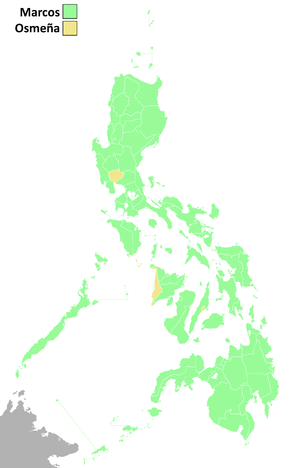
Provinces where Marcos won at least a plurality are in light green.
-
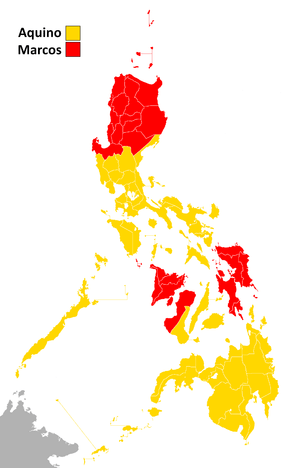
Provinces where Marcos won at least a plurality are in red. This is the clearest manifestation of the Solid North.
-
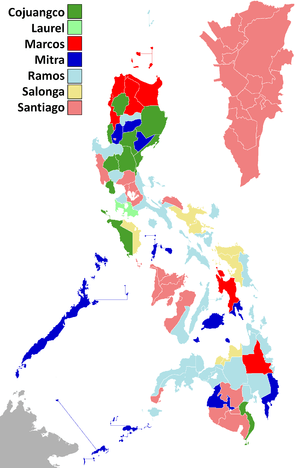
Provinces where Marcos won at least a plurality are in red; provinces where Marcos' ally Danding Cojuangco won at least a plurality are in dark green.
-
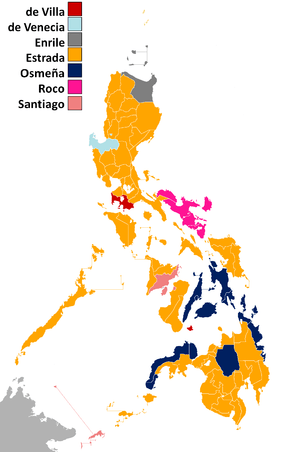
Provinces where Estrada won at least a plurality are in orange. The Marcoses supported Estrada in the election.
-
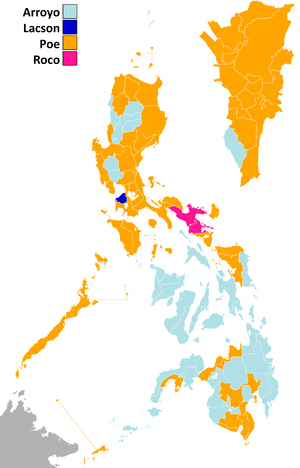
Provinces where Poe won at least a plurality are in orange. The Marcoses supported Poe in the election.
-
.png)
Provinces where Villar won at least a plurality are in light green. The Marcoses supported Villar in the election.
The North in the presidential elections
Key:
- Boldface: Winner
- Italicized: Marcos, or candidate supported by the Marcoses.
The North in the vice-presidential elections
Key:
- Boldface: Winner
- Italicized: Marcos, or candidate that has running mate or supported by the Marcoses.
See also
- Lingayen-Lucena corridor, where the national elections have said to be "won".
- Solid South, American counterpart
Notes
References
- "3 wins in Philippine elections mark Marcos family's highest rise since dictator ousted in 1986". Associated Press. Fox News. 2010-05-10.
- Quinn-Judge, Paul (1986-02-04). "What you need to know about THE PHILIPPINE ELECTION. A presidential election: issues and candidates". The Christian Science Monitor.
- Tan, Samuel K. (1987). A history of the Philippines. University of the Philippines Press. ISBN 9789715425681.